
How to Use PCM5102A I2S DAC: Examples, Pinouts, and Specs
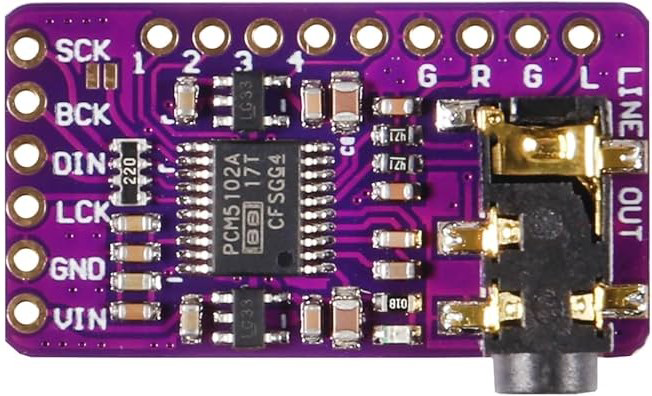
 Design with PCM5102A I2S DAC in Cirkit Designer
Design with PCM5102A I2S DAC in Cirkit DesignerIntroduction
The PCM5102A is a high-performance digital-to-analog converter (DAC) manufactured by Generic. It is designed to convert digital audio signals into high-quality analog audio output. The device supports the I2S (Inter-IC Sound) protocol for audio data input and is capable of processing 32-bit audio with sampling rates up to 384 kHz. With its low distortion, low noise, and high dynamic range, the PCM5102A is ideal for high-fidelity audio applications.
Explore Projects Built with PCM5102A I2S DAC
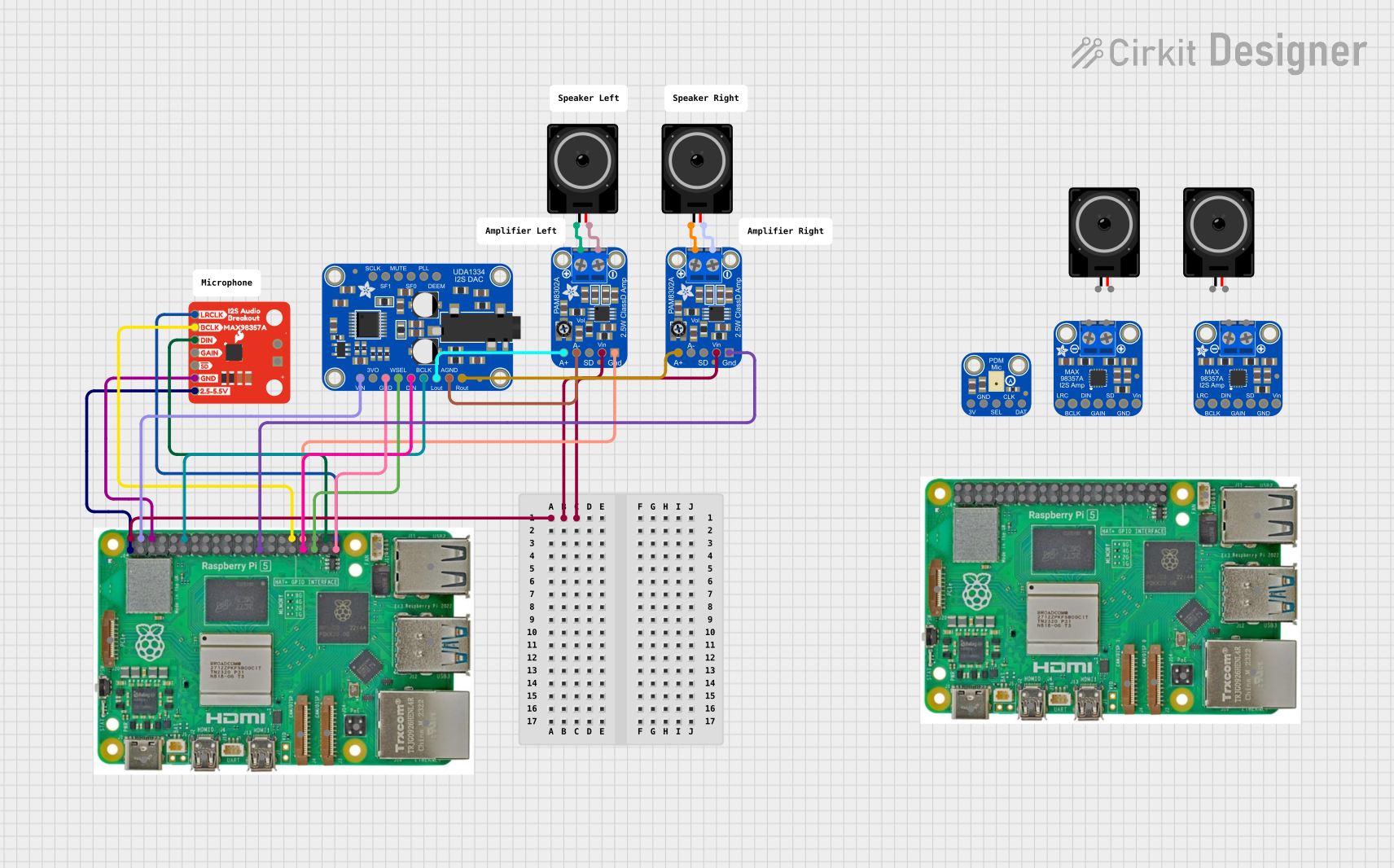
 Open Project in Cirkit Designer
Open Project in Cirkit Designer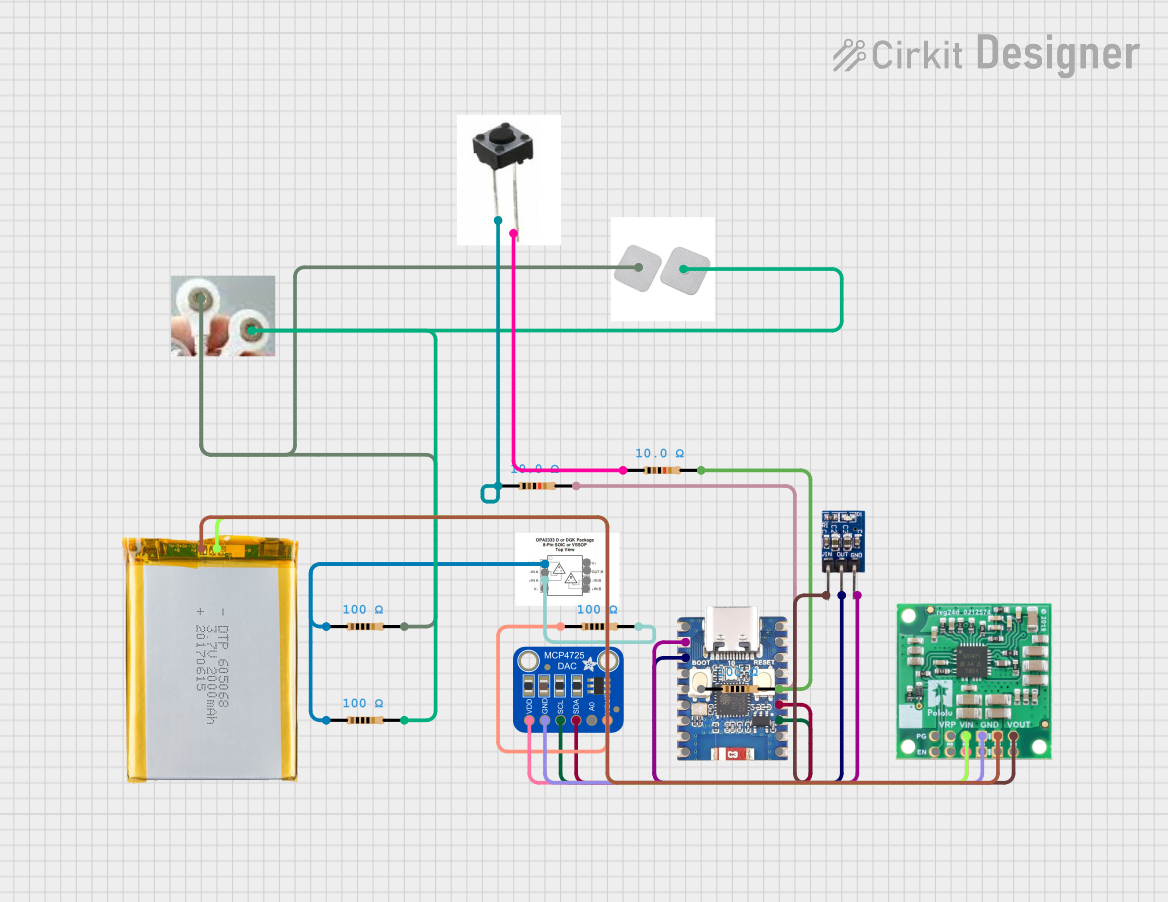
 Open Project in Cirkit Designer
Open Project in Cirkit Designer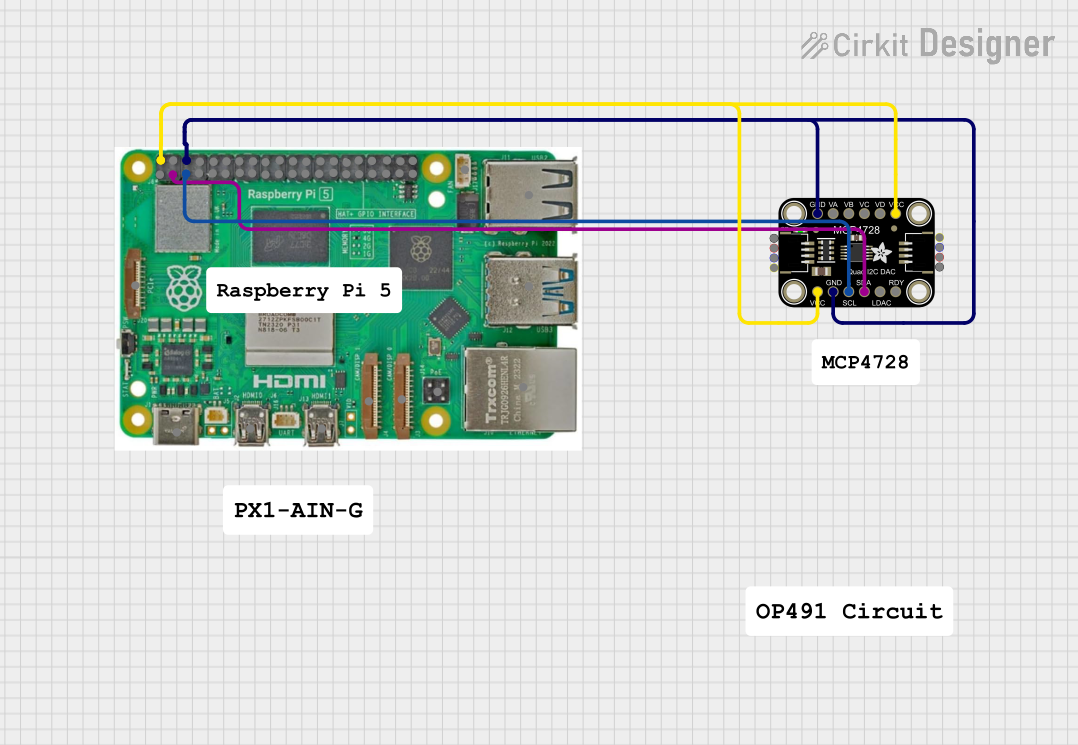
 Open Project in Cirkit Designer
Open Project in Cirkit Designer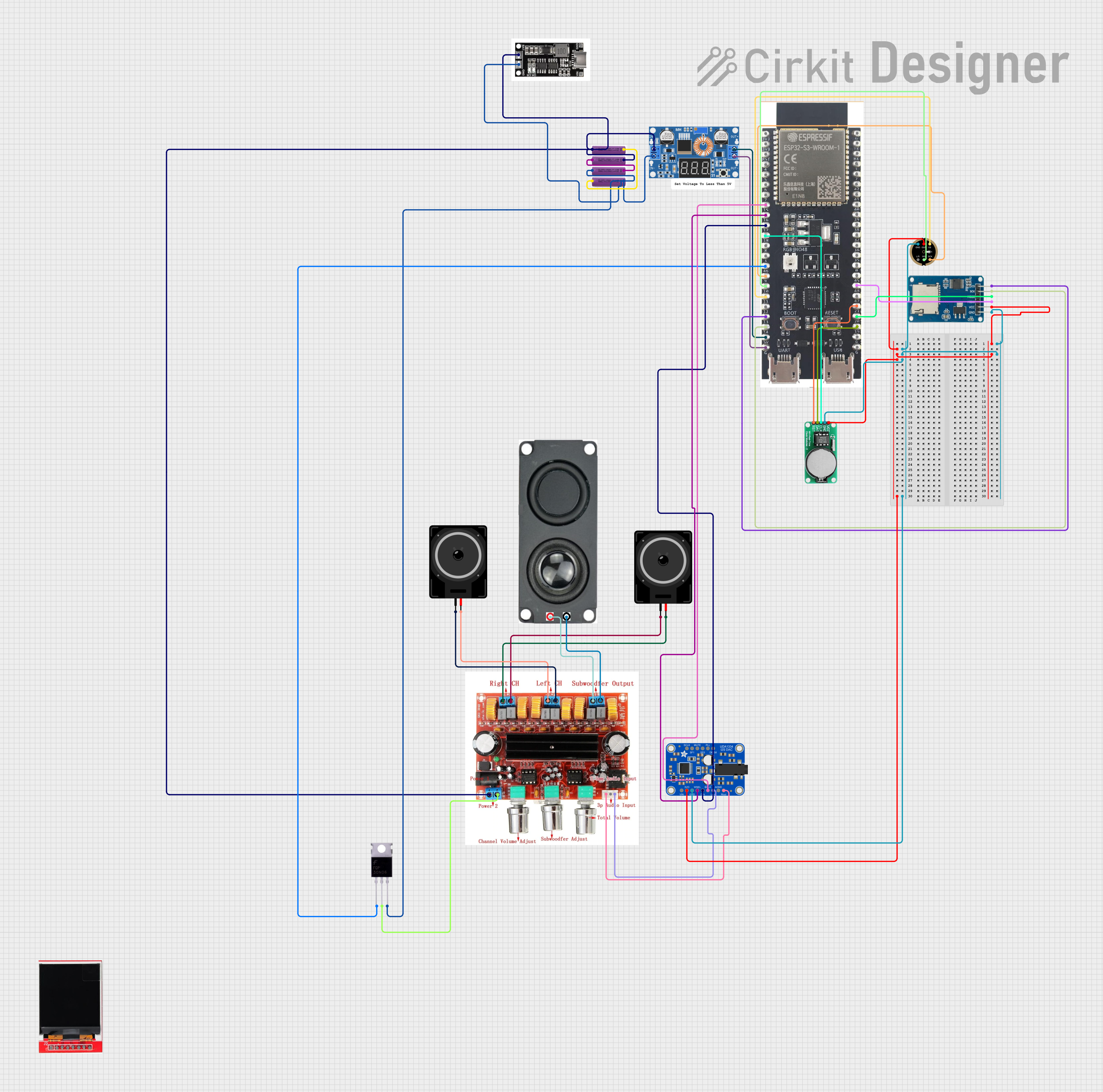
 Open Project in Cirkit Designer
Open Project in Cirkit DesignerExplore Projects Built with PCM5102A I2S DAC

 Open Project in Cirkit Designer
Open Project in Cirkit Designer
 Open Project in Cirkit Designer
Open Project in Cirkit Designer
 Open Project in Cirkit Designer
Open Project in Cirkit Designer
 Open Project in Cirkit Designer
Open Project in Cirkit DesignerCommon Applications
- High-end audio systems
- Digital music players
- Audio interfaces
- Home theater systems
- Embedded audio solutions
Technical Specifications
Key Technical Details
| Parameter | Value |
|---|---|
| Manufacturer Part ID | PCM5102A |
| Input Protocol | I2S |
| Audio Resolution | Up to 32-bit |
| Sampling Rate | Up to 384 kHz |
| Signal-to-Noise Ratio (SNR) | 112 dB |
| Total Harmonic Distortion + Noise (THD+N) | -93 dB |
| Power Supply Voltage | 3.3V (typical) |
| Output Voltage | 2.1 Vrms (typical) |
| Operating Temperature Range | -25°C to 85°C |
| Package Type | TSSOP-20 |
Pin Configuration and Descriptions
The PCM5102A comes in a 20-pin TSSOP package. Below is the pin configuration:
| Pin Number | Pin Name | Description |
|---|---|---|
| 1 | DVDD | Digital power supply (3.3V) |
| 2 | DGND | Digital ground |
| 3 | LRCK | Left/Right clock input for I2S |
| 4 | BCK | Bit clock input for I2S |
| 5 | DIN | Serial data input for I2S |
| 6 | SCK | System clock input (optional) |
| 7 | FMT | Audio format selection |
| 8 | XSMT | Soft mute control |
| 9 | FLT | Filter response selection |
| 10 | VCOM | Common-mode voltage output |
| 11 | VOUTL | Left channel analog output |
| 12 | VOUTR | Right channel analog output |
| 13 | AGND | Analog ground |
| 14 | AVDD | Analog power supply (3.3V) |
| 15 | NC | No connection |
| 16 | NC | No connection |
| 17 | NC | No connection |
| 18 | NC | No connection |
| 19 | NC | No connection |
| 20 | NC | No connection |
Usage Instructions
How to Use the PCM5102A in a Circuit
- Power Supply: Connect the digital (DVDD) and analog (AVDD) power supply pins to a stable 3.3V source. Ensure proper decoupling capacitors are placed close to the power pins to minimize noise.
- Grounding: Connect DGND and AGND to a common ground plane to avoid ground loops.
- I2S Interface:
- Connect the I2S signals (LRCK, BCK, and DIN) from your microcontroller or audio source to the corresponding pins on the PCM5102A.
- If a system clock (SCK) is required, provide a stable clock signal to the SCK pin.
- Audio Output: Connect the VOUTL and VOUTR pins to the left and right audio output channels, respectively. Use appropriate filtering or amplification circuits if needed.
- Control Pins:
- Use the FMT pin to select the desired audio format (e.g., I2S, left-justified, right-justified).
- Use the XSMT pin to enable or disable the soft mute feature.
- Use the FLT pin to select the desired filter response (e.g., sharp or slow roll-off).
Important Considerations and Best Practices
- Decoupling: Place decoupling capacitors (e.g., 0.1 µF and 10 µF) close to the power supply pins to reduce noise and ensure stable operation.
- PCB Layout: Use a ground plane and keep the analog and digital sections of the circuit isolated to minimize interference.
- Clock Signal: Ensure the I2S clock signals (LRCK, BCK, and SCK) are clean and free from jitter to maintain audio quality.
- Output Loading: Avoid connecting heavy loads directly to the VOUTL and VOUTR pins. Use a buffer or amplifier if necessary.
Example: Connecting PCM5102A to an Arduino UNO
The PCM5102A can be interfaced with an Arduino UNO using the I2S protocol. Below is an example code snippet to output audio data:
#include <I2S.h> // Include the I2S library for Arduino
void setup() {
// Initialize the I2S interface
if (!I2S.begin(I2S_PHILIPS_MODE, 44100, 32)) {
// Check if I2S initialization failed
while (1) {
// Stay in an infinite loop if initialization fails
}
}
}
void loop() {
// Generate a simple sine wave for testing
for (int i = 0; i < 360; i++) {
// Calculate the sine wave value
int sample = 32767 * sin(i * PI / 180);
// Write the sample to the I2S DAC
I2S.write(sample);
}
}
Note: The Arduino UNO requires an external I2S interface module, as it does not natively support I2S. Use an I2S-compatible microcontroller (e.g., ESP32) for direct interfacing.
Troubleshooting and FAQs
Common Issues and Solutions
No Audio Output:
- Verify that the power supply connections (DVDD and AVDD) are correct and stable.
- Check the I2S connections (LRCK, BCK, and DIN) for proper wiring and signal integrity.
- Ensure the audio source is configured to output I2S data in a compatible format.
Distorted Audio:
- Verify that the I2S clock signals (LRCK, BCK, and SCK) are free from jitter.
- Check the output load on VOUTL and VOUTR. Use a buffer or amplifier if needed.
- Ensure the power supply is clean and free from noise.
Device Overheating:
- Check for excessive current draw. Ensure proper decoupling capacitors are in place.
- Verify that the power supply voltage does not exceed the recommended 3.3V.
FAQs
Q1: Can the PCM5102A operate without an external system clock (SCK)?
A1: Yes, the PCM5102A can operate in master mode without an external SCK. However, for optimal performance, it is recommended to provide a stable system clock.
Q2: What audio formats does the PCM5102A support?
A2: The PCM5102A supports I2S, left-justified, and right-justified audio formats. The format can be selected using the FMT pin.
Q3: Can I use the PCM5102A with a 5V microcontroller?
A3: Yes, but you must use level shifters to convert the 5V logic signals to 3.3V, as the PCM5102A operates at 3.3V logic levels.
Q4: What is the maximum sampling rate supported by the PCM5102A?
A4: The PCM5102A supports sampling rates up to 384 kHz. Ensure your audio source and I2S interface are configured accordingly.